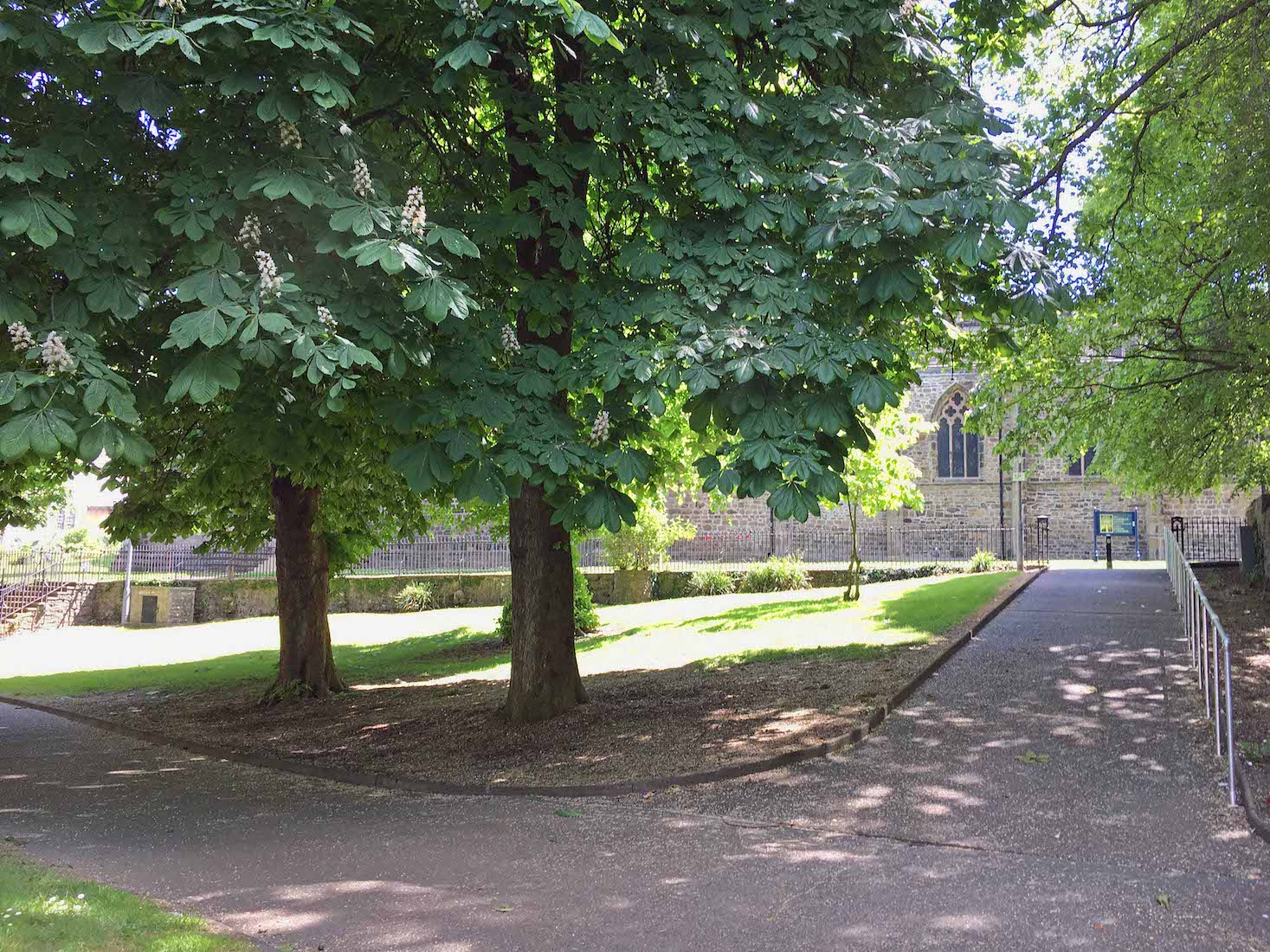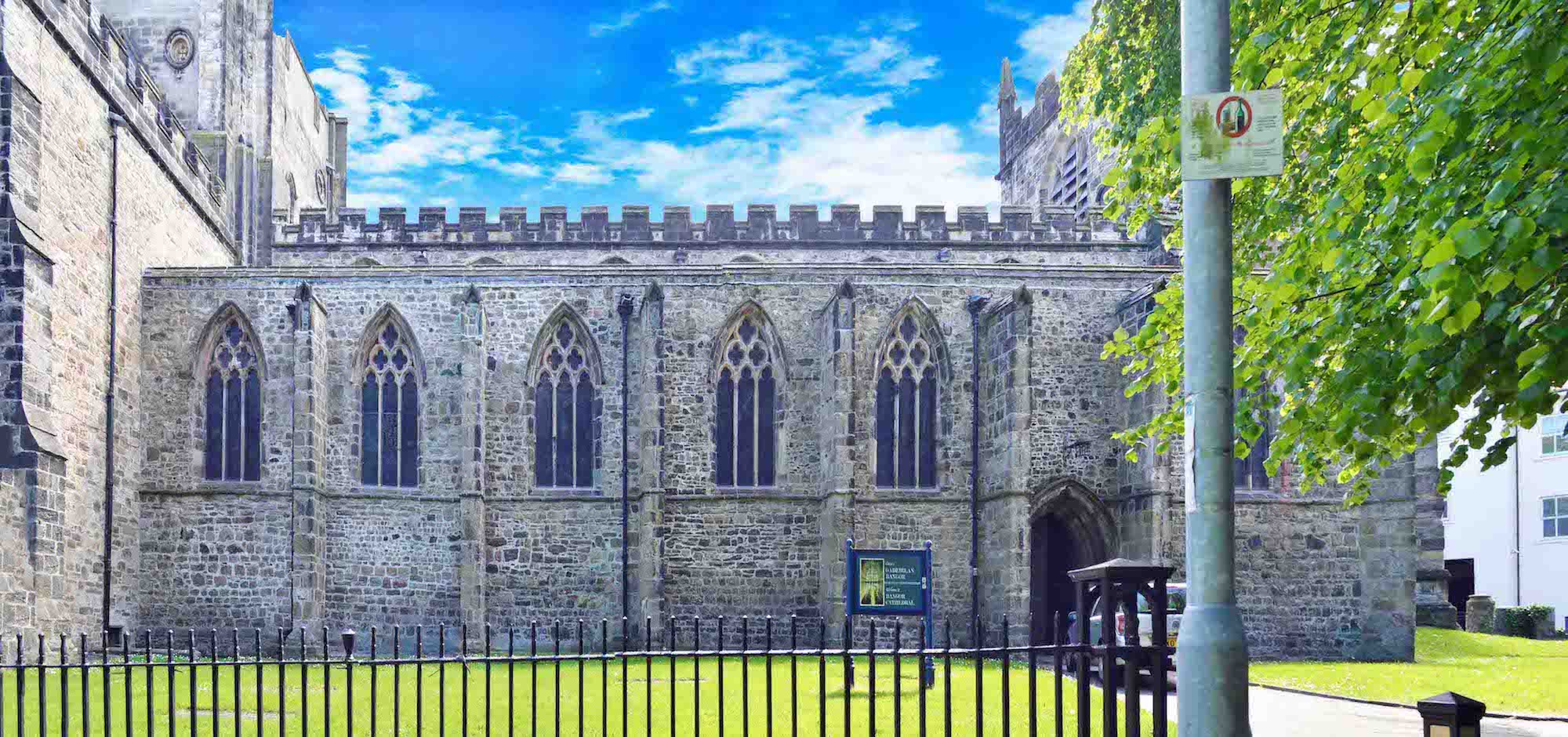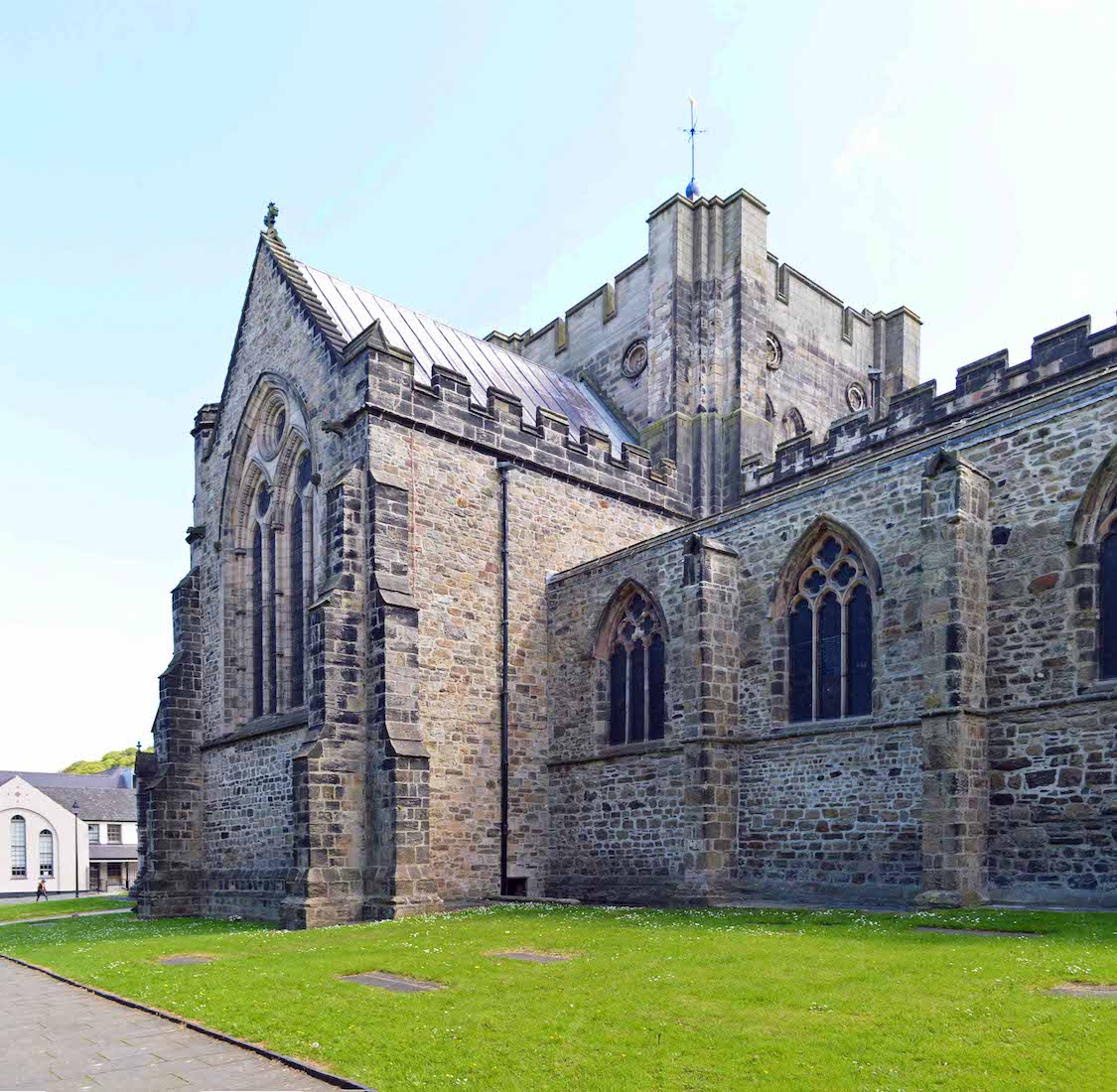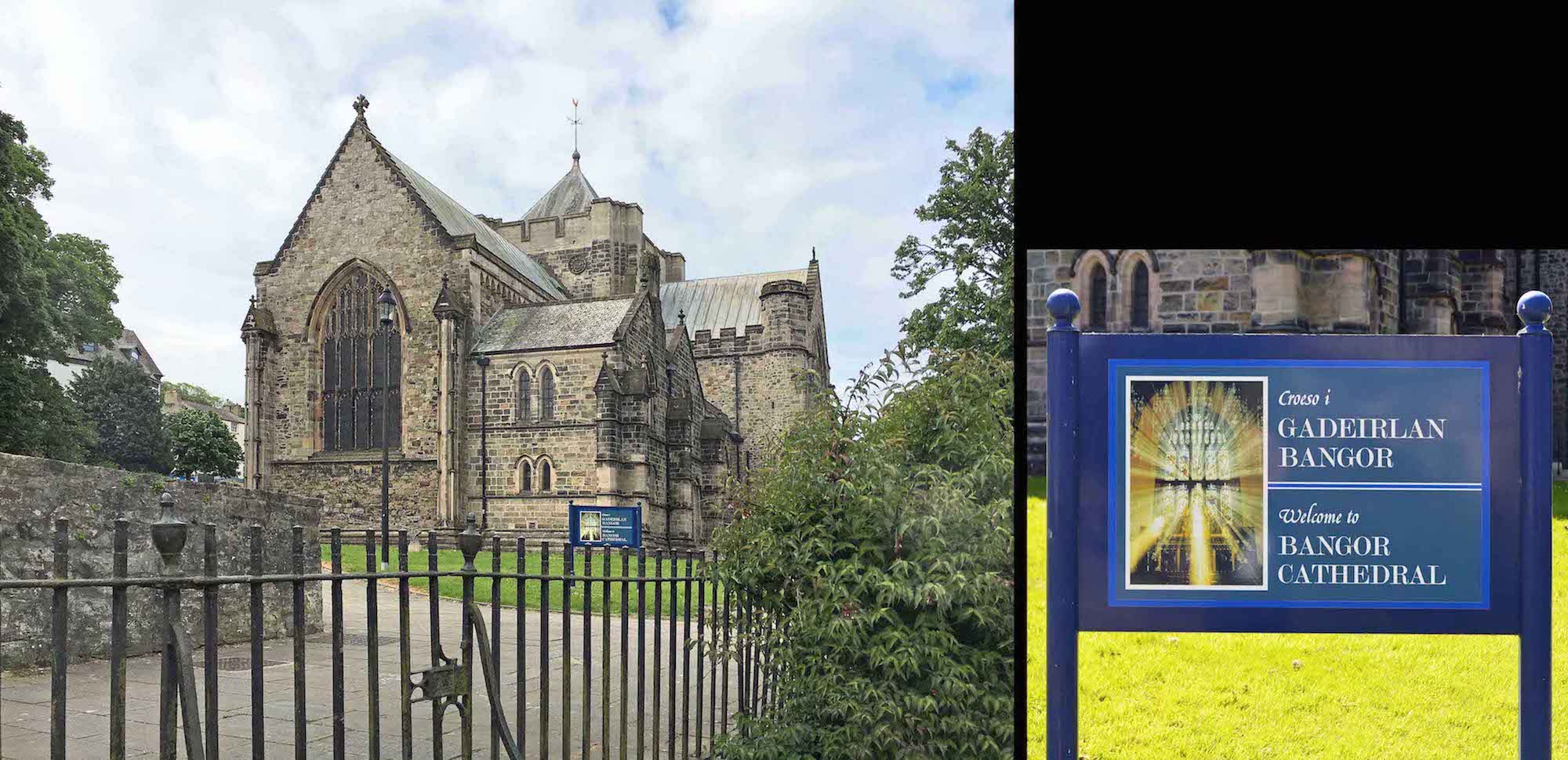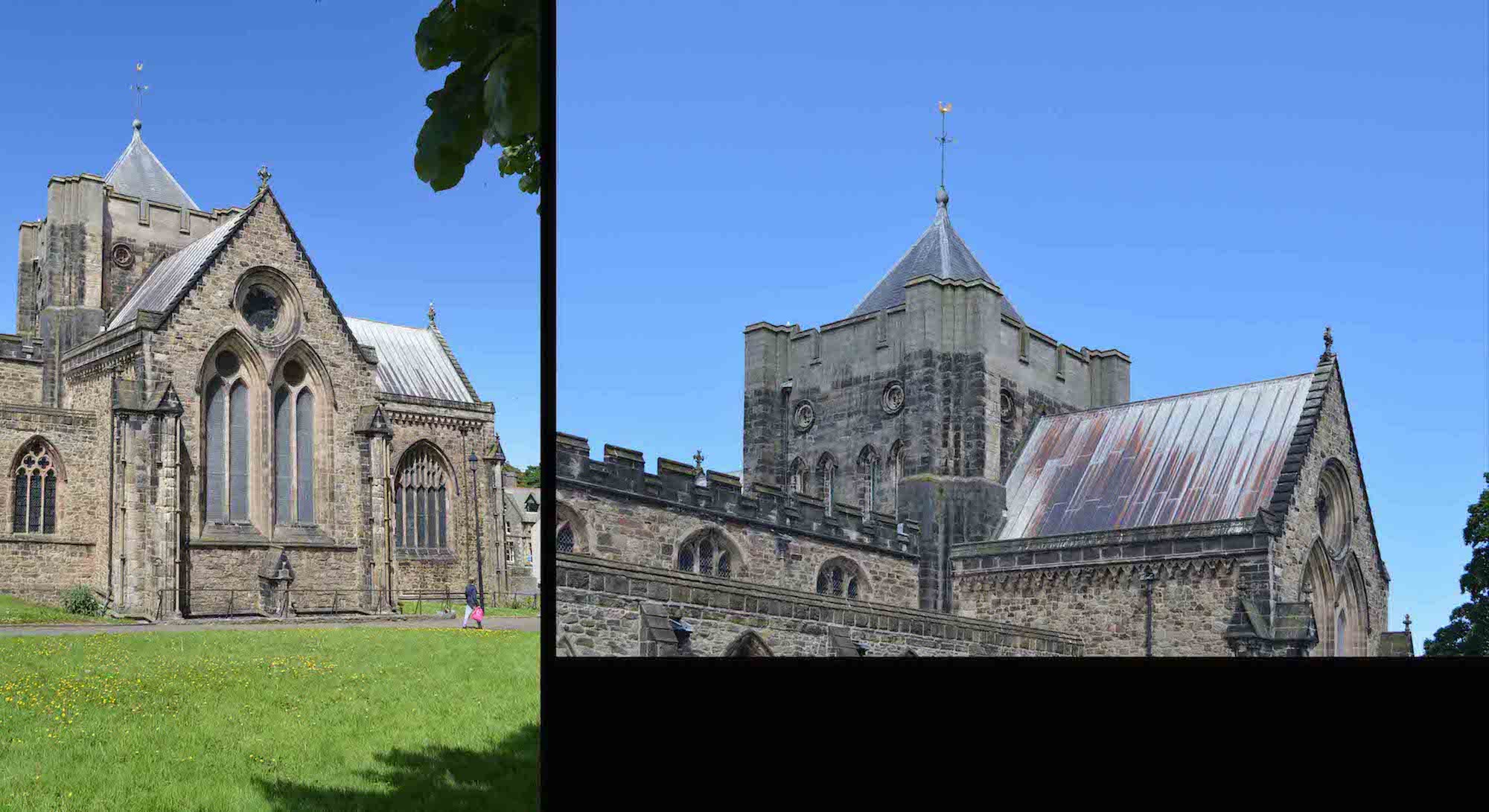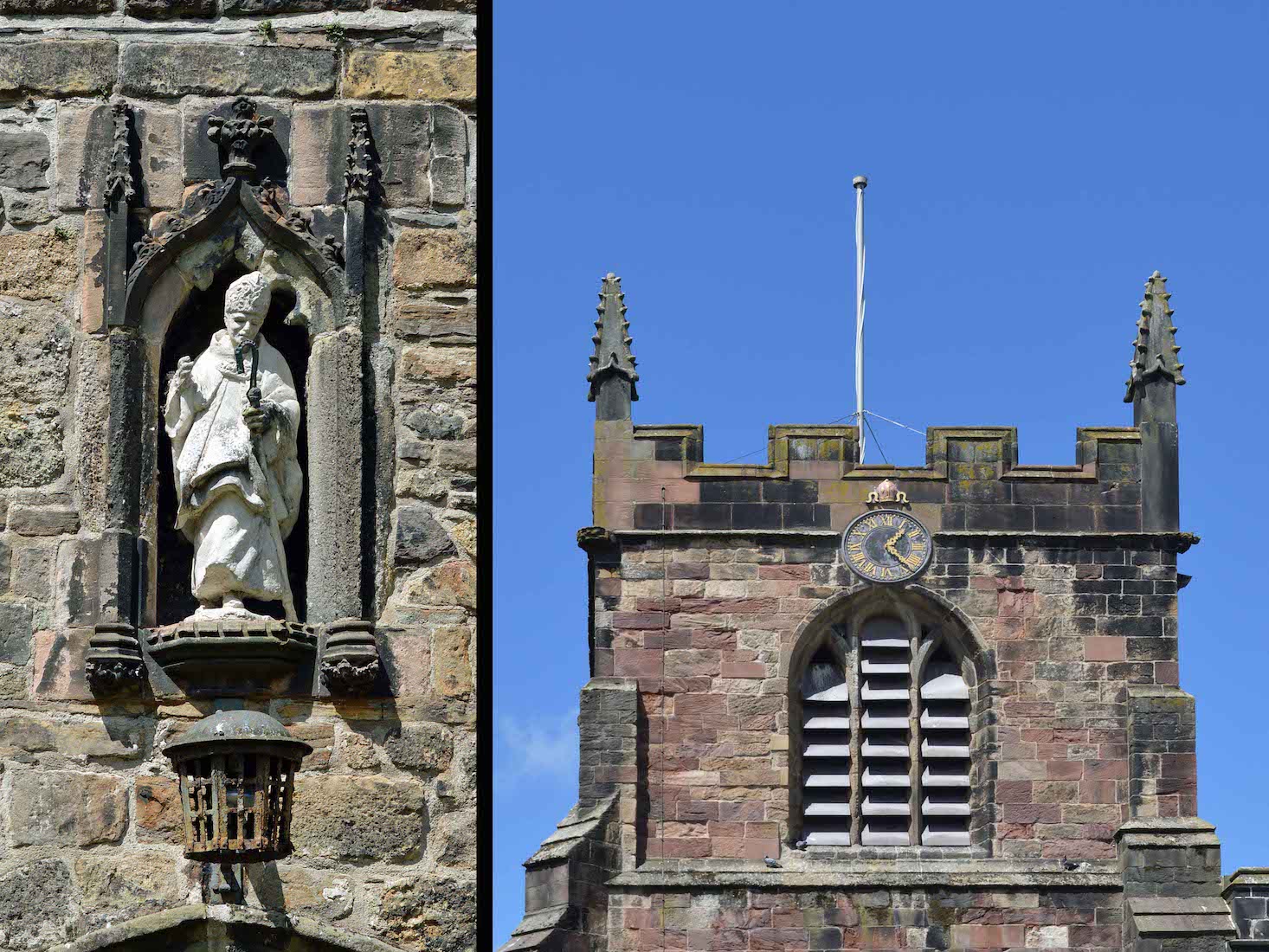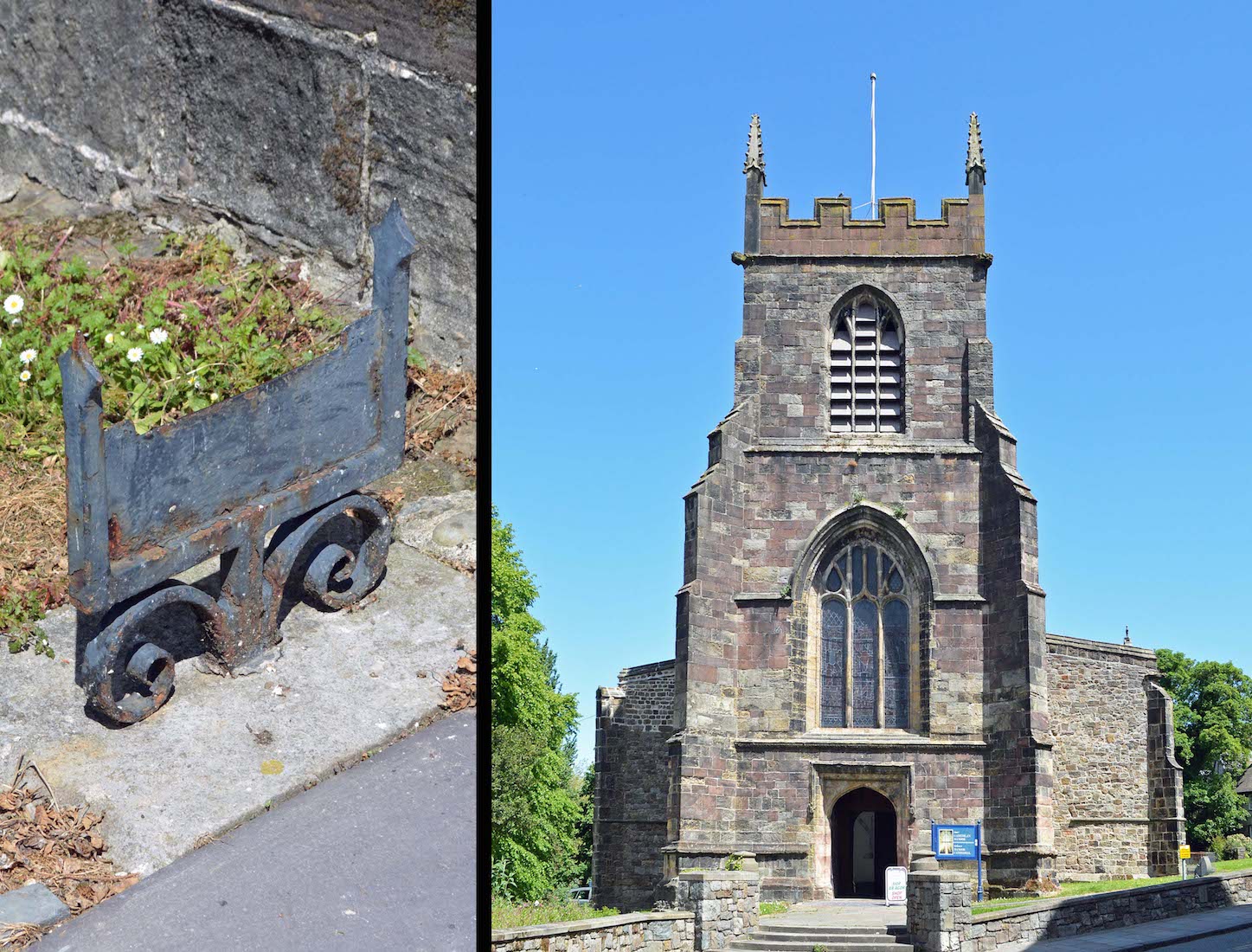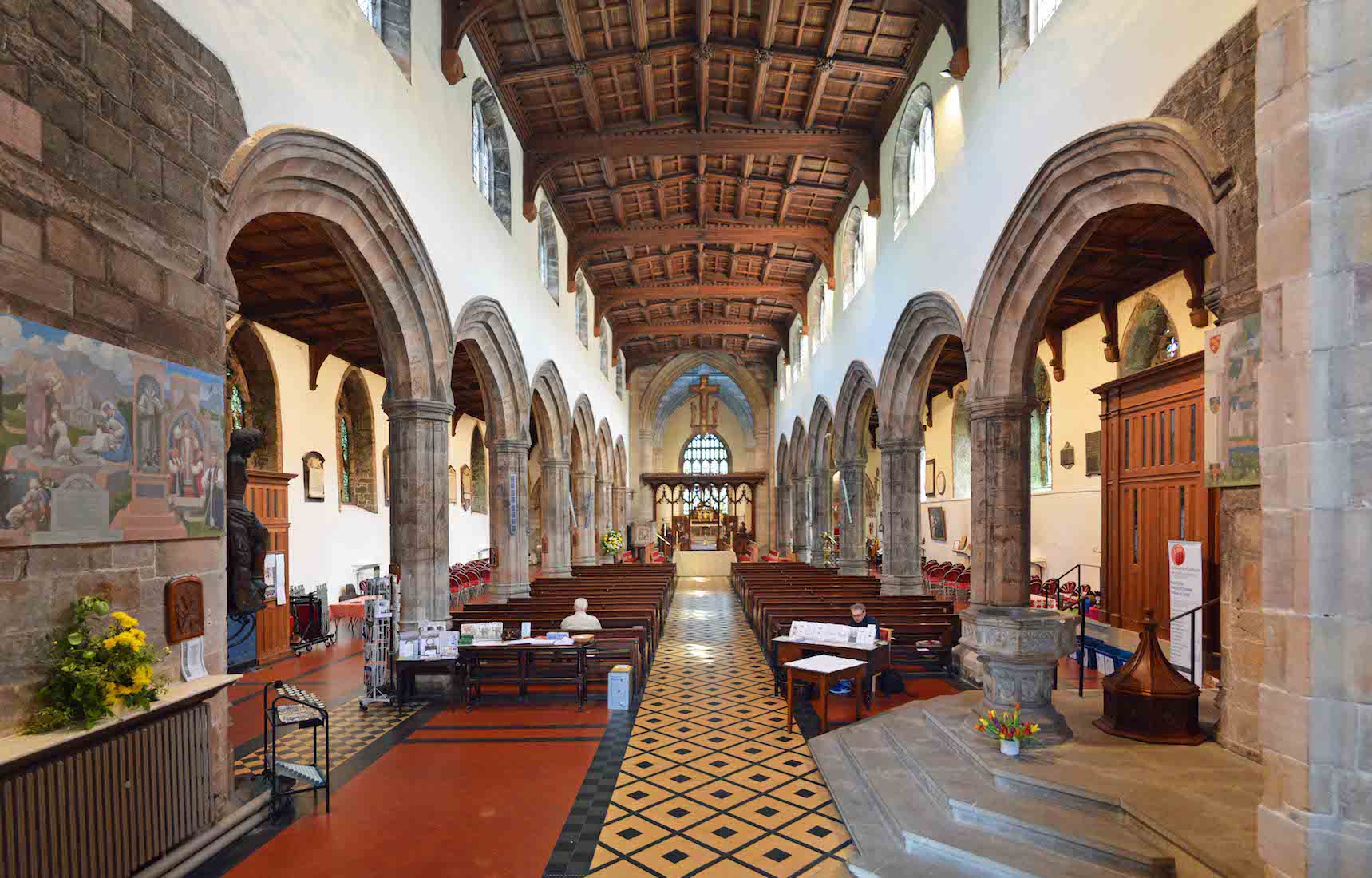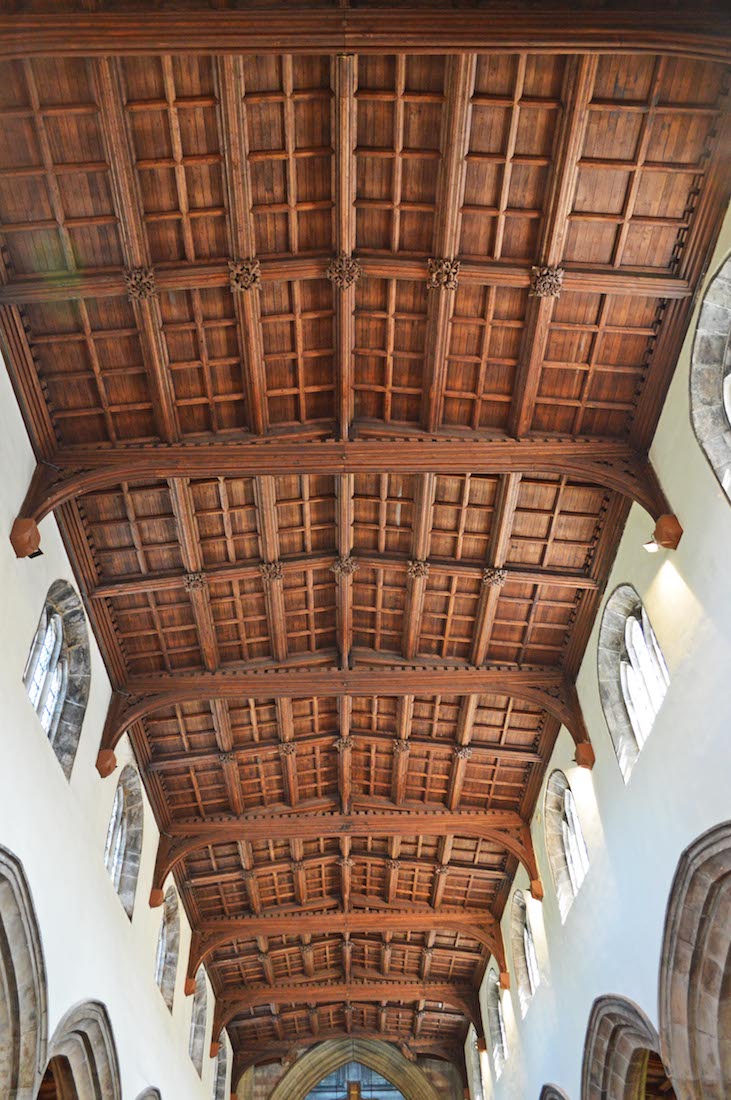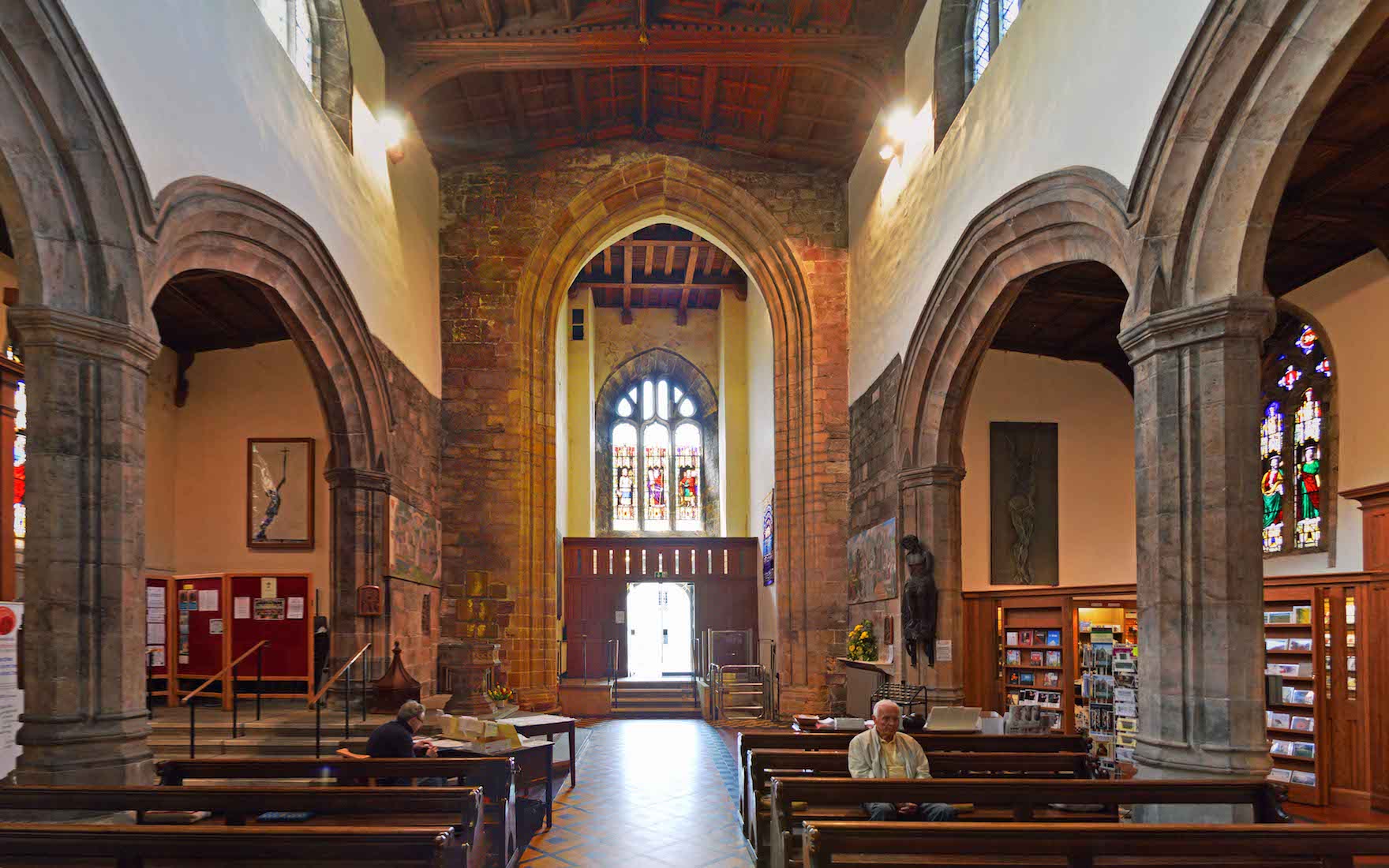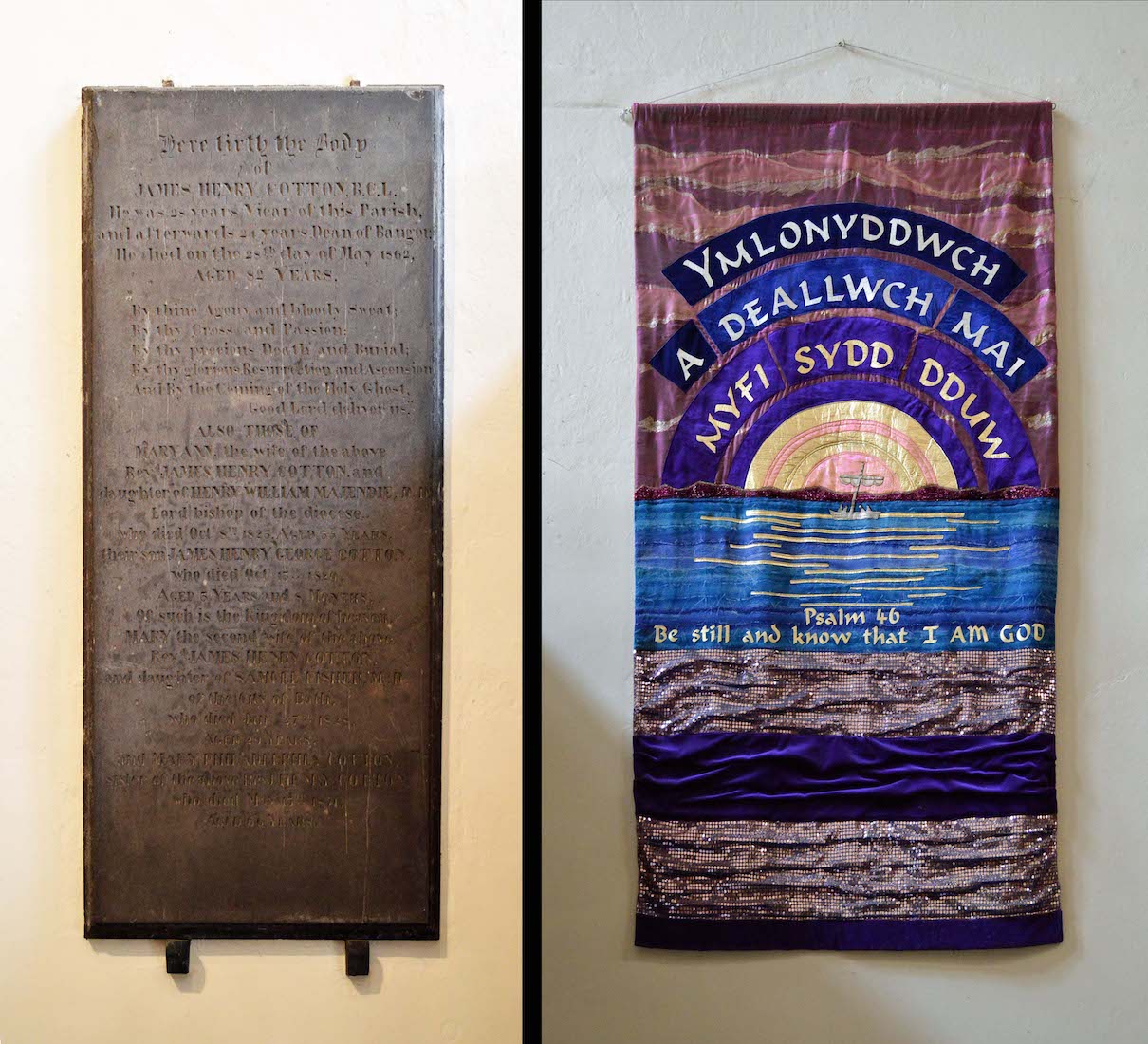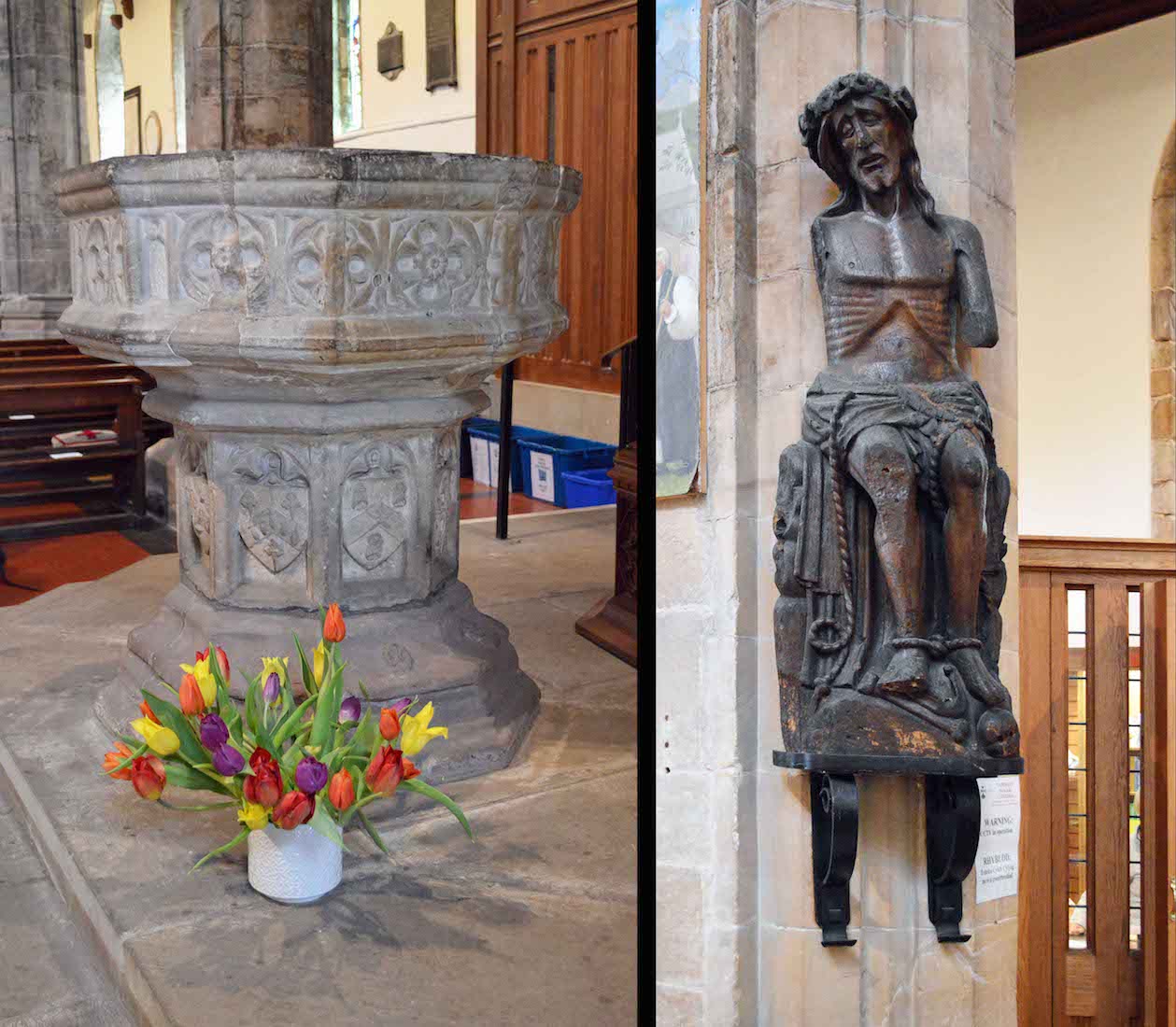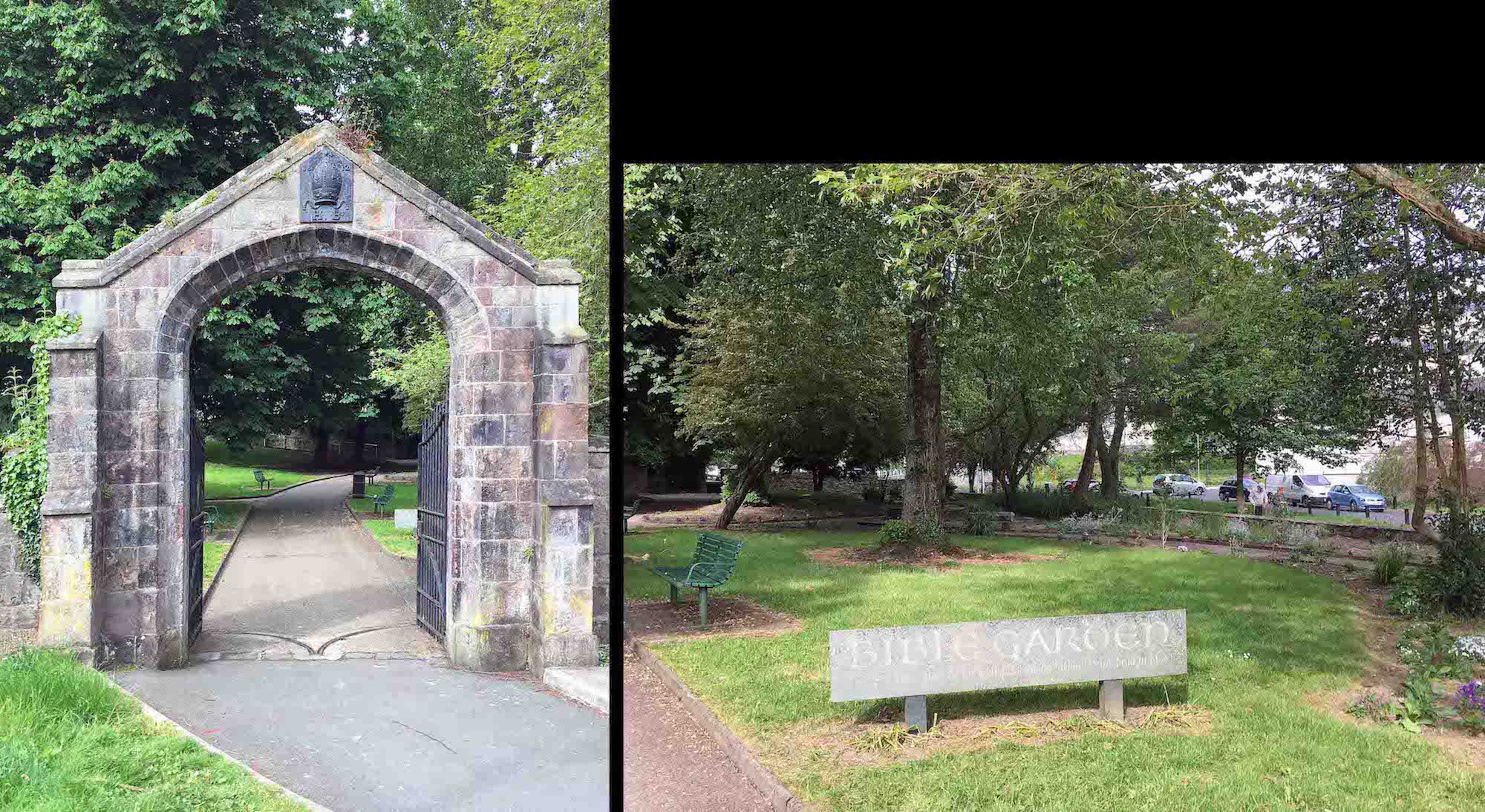
The gateway entrance to the Bible Garden is to the Northeast of the Cathedral, and we approach the Cathedral this way. The Garden is intended to demonstrate the various plants found in Palestine. ••• Bangor Cathedral (Welsh: Eglwys Gadeiriol Bangor) is an ancient place of Anglican (Church in Wales) worship in Bangor, Gwynedd, Wales. It is dedicated to its founder, Saint Deiniol. The site of the present building of Bangor Cathedral has been in use as a place of Christian worship since the 6th century. PLAN
2. BIBLE GARDEN VIEW

The Bible Garden is a pleasant enough area, but there are no plant labels or other useful identifying information. ••• About the year 530AD a man of noble birth named Deiniol settled on this site. Having been given land, probably by Maelgwn, King of Gwynedd, he enclosed it with a fence constructed by driving poles into the ground and weaving branches in between them. The native technical term for this type of fence was ‘bangor’. Within this enclosure Deiniol built his church.
3. BIBLE GARDEN FLOWER BED
In fact much of the Garden planting is quite sparse. We might perhaps expect to find an apple tree, a rose of Sharon, lilies of the field, aloe, fig, grape vine, ... . Not obvious! ••• Deiniol and his followers erected huts or cells in which to live. They were missionaries, going about evangelising and encouraging others to join them. All who came, individuals and families, built their own dwelling places and all would worship together in the little church. Thus a Celtic monastery or Clas was formed.
4. FIRST GLIMPSE OF CATHEDRAL
As we reach the Western limit of the garden, we turn and catch our first glimpse of the Cathedral rising above us. ••• As sometimes happens, the word ‘bangor’ was transferred from the original object – in this case the fence – to that closely associated with it – the settlement within. That is how Bangor got its name. The Cathedral is built on a low-lying and inconspicuous site, possibly so as not to attract the attention of Viking raiders from the sea. The Cathedral is built in Gothic style.
5. NORTH NAVE
Climbing some steps up to the Cathedral, we turn left to follow around the North side in a clockwise direction. Our plan is to circumnavigate the Cathedral. ••• The site of Bangor Cathedral was originally occupied by St Deiniol's Monastery, established in the 6th century around 530 on land given by the king of Gwynedd, Maelgwn Gwynedd. Deiniol is said to have been consecrated as a bishop by Saint David, making him the first Bishop of Bangor. This monastery was sacked in 634 and again in 1073. Nothing of the original building survives.
6. NORTH TRANSEPT
We follow around past the North transept. The Bible Garden is below us, on our left. ••• The Synod of Westminster in 1102 is recorded as taking measures to restore Bangor Cathedral, but the earliest part of the present building was built during the episcopate of Bishop David (1120–1139) with the assistance of the king of Gwynedd, Gruffudd ap Cynan, who donated money towards the project and was buried by the high altar on his death in 1137. This early building was cruciform and in the Norman style, about 44 yards in length.
7. NORTH WALL EAST
Between the chancel / sanctuary and the North transept we find this rather nondescript addition, presumably now used for vestries and administration. ••• Gruffudd's son, Owain Gwynedd, was also buried here, as was his brother Cadwaladr. Giraldus Cambrensis describes a service held here in 1188 when the Archbishop of Canterbury celebrated Mass. In 1211, the cathedral was destroyed by King John’s army, on a raid into Gwynedd. In the 13th century the original apse was removed and the choir was extended to its present length.
8. EASTERN VIEW
At the East end we step briefly ‘beyond the pale’ for this view. A smart Cathedral sign bids us welcome in Welsh and English. ••• The church was badly damaged when King Edward I invaded Gwynedd in 1282, and in 1284 the dean and chapter were given £60 in compensation for the damage. There was extensive rebuilding in this period, under the first Bishop Anian, with the transepts and crossing rebuilt. In the 13th century the original apse was removed and the choir was extended to its present length.
9. SOUTH TRANSEPT AND SANCTUARY
We continue our exploration around to the South side. ••• The nave was rebuilt in the late 14th century. The Cathedral was said to have been burnt to the ground in 1402 during the rebellion of Owain Glyndŵr, but there is no contemporary evidence for this, though it may well have been damaged. There certainly was extensive reconstruction from the end of the 15th century, completed in 1532.
10. SOUTH TRANSEPT AND TOWER
There is a solid square tower at the crossing where the transepts cross the axis of the Cathedral. The tower is surmounted by a small square pyramidal roof and weather vane. ••• There is a Latin inscription over the tower doorway recording that Bishop Skevington built the tower in 1532, though it was not complete when Skevington died in 1533. Some work was done during the 18th century and £2,000 was spent on repairs in 1824, followed by the altering and refitting of the interior in 1825 at a cost of a further £3,252.
11. SOUTH NAVE
This is perhaps the best view of the Cathedral. ••• Rowland Meyrick, the second son of Meyric ap Llewelyn, was the first Bishop of Bangor following the Reformation and is buried under the cathedral. Meyric ap Llewelyn was High Sheriff and Captain of the Guard at the coronation of Henry VIII on 26 April 1509. The building as seen today is the result of extensive work carried out under the supervision of George Gilbert Scott, starting in 1868. Scott's design originally called for a high central tower and spire, but this was never completed as cracks appeared which were thought to indicate subsidence of the foundations. The tower was therefore left as a low structure. In 1879 £11,000 was spent on the restoration of the nave, chapter house and central tower. In 1966-1967, the stump of Scott’s central tower was finished off with battlements, a pyramid cap and a tall weather cock. Major restoration of the outside stonework and roofs began in 1987 and continues.
12. ST DEINIOL AND TOWER
The Western tower has a Western niche containig a figure of St Deiniol and on the South side a clock below a bishop’s mitre. ••• In summary, Saint Deiniol (died 584) was traditionally the first Bishop of Bangor. The present Bangor Cathedral, dedicated to Deiniol, is said to be on the site where his monastery stood. In English and Latin his name is sometimes rendered as Daniel.
13. WEST DOOR
The main entry to the Cathedral is through the West door, which is at the base of the West tower. There is an historic boot scraper right by the door! We have now completed our circuit of this old Cathedral, and it is time for us to go inside.
14. NAVE
As we stand with the nave before us, we reflect on the many years of history of this sacred space. We notice the paintings on either side of us, and the baptistry to the right just before us. Two rows of Gothic arches separate the side aisles, and above us, light streams through the clear clerestory windows. Stations of the cross are fixed to the columns at left. The central aisle leads down to the nave altar with the choir and sanctuary beyond.
15. NAVE ROOF
The nave roof is an almost flat gable supported by cross rafters. There are carved bosses, but these are almost invisible, lost in the natural colour of the timber.
16. WEST NAVE
If we look back from the centre of the Cathedral we obsserve the West nave. There is a single window in the West wall, above the main doors. We observe the baptismal font at left, the figure of Christ at right, the Cathedral shop in the Northwest nave, and various memorials and works of art.
17. ENTRY MEMORIAL AND BANNER
On entry through the West doors there is a plaque on our right and a banner on our left. The tombstone remembers James Henry Cotton who was Vicar and then Dean of this Cathedral, along with members of his family The main text of the banner is in Welsh and has the theme ‘Be still and know that I am God’ (Psalm 46).
18. FONT AND ST DEINIOL
The old carved stone font stands prominently by the entrance. It takes three people to remove the solid oak cap! The figure of St Deiniol stands in the small wall niche behind.
19. ENTRY MURALS
These paintings are by British church artist Brian Thomas (1912 – 1989). Thomas is known for his church murals and stained glass windows. The (South) mural at left illustrates the cathedral churches of Wales. The (North) mural at right shows various significant figures in Welsh church history including St David, William Morgan, John Davies and Griffith Jones.
20. FONT AND MOSTYN CHRIST
Baptism is regarded as a rite of initiation into the Church and into the Christian life. It is therefore common to find the font close to the entrance of a church or cathedral. The Mostyn Christ (c.1450) at rght is one of the most iconic religious representations surviving from 15th century Wales and is an item shrouded in mystery as to its origins. The wooden carving of the bound Christ seeks to reflect the meaning of the Passion through the intense depiction of human suffering and the symbolic inclusion of a skull at the feet of Christ. Its name comes from the fact that by the early 19th century the item was in the possession of the Mostyn family at Gloddaith hall.



